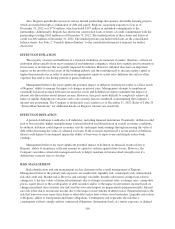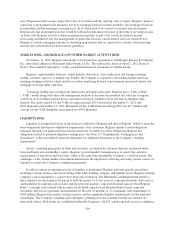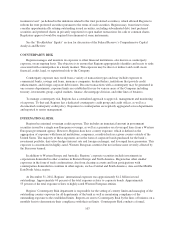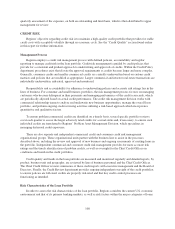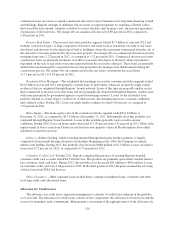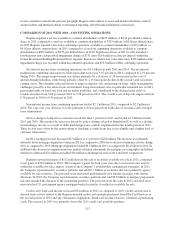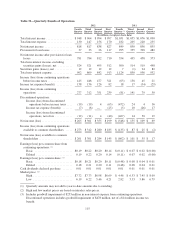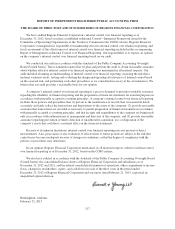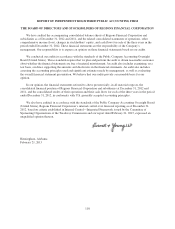Regions Bank 2012 Annual Report Download - page 126
Download and view the complete annual report
Please find page 126 of the 2012 Regions Bank annual report below. You can navigate through the pages in the report by either clicking on the pages listed below, or by using the keyword search tool below to find specific information within the annual report.commercial loans are owner-occupied commercial real estate loans to businesses for long-term financing of land
and buildings. Regions attempts to minimize risk on owner-occupied properties by requiring collateral values
that exceed the loan amount, adequate cash flow to service the debt, and, in many cases, the personal guarantees
of principals of the borrowers. Net charge-offs on commercial loans were 0.89 percent in 2012 compared to
1.40 percent in 2011.
Investor Real Estate—The investor real estate portfolio segment totaled $7.7 billion at year-end 2012 and
includes various loan types. A large component of investor real estate loans is extensions of credit to real estate
developers and investors for the financing of land or buildings, where the repayment is generated from the sale of
the real estate or income generated by the real estate property. Net charge-offs on commercial investor real estate
mortgage loans were 2.22 percent in 2012, as compared to 5.52 percent in 2011. Commercial investor real estate
construction loans are primarily extensions of credit to real estate developers or investors where repayment is
dependent on the sale of real estate or income generated from the real estate collateral. These loans are generally
underwritten and managed by a specialized real estate group that also manages loan disbursements during the
construction process. Net charge-offs on commercial investor real estate construction decreased from
11.71 percent in 2011 to 4.03 percent in 2012.
Residential First Mortgage—The residential first mortgage class in the consumer portfolio segment totaled
$13.0 billion at year-end 2012 and primarily contains loans to individuals, which are secured by single-family
residences that are originated through Regions’ branch network. Loans of this type are generally smaller in size
than commercial or investor real estate loans and are geographically dispersed throughout Regions’ market areas,
with some guaranteed by government agencies or private mortgage insurers. Losses on the residential loan
portfolio depend, to a large degree, on the level of interest rates, the unemployment rate, economic conditions
and collateral values. During 2012, losses on single-family residences totaled 1.06 percent, as compared to
1.52 percent in 2011.
Home Equity—The home equity class in the consumer portfolio segment totaled $11.8 billion at
December 31, 2012, as compared to $13.0 billion at December 31, 2011. Substantially all of this portfolio was
originated through Regions’ branch network. Losses in this portfolio generally track overall economic
conditions. During 2012, losses on home equity decreased to 1.90 percent from 2.41 percent in 2011. Most of the
improvement in losses came from Florida second liens because property values in Florida markets have either
stabilized or started to increase.
Indirect—Indirect lending, which is lending initiated through third-party business partners, is largely
comprised of loans made through automotive dealerships. Beginning in late 2010, the Company re-entered
indirect auto lending. During 2012, this portfolio class increased $488 million to $2.3 billion. Losses on indirect
loans were 0.72 percent for 2012, as compared to 0.75 percent for 2011.
Consumer Credit Card—During 2011, Regions completed the purchase of existing Regions-branded
consumer credit card accounts from FIA Card Services. The products are primarily open-ended variable interest
rate consumer credit card loans. During 2012, this portfolio class decreased $81 million to $906 million. Losses
on consumer credit card were 4.68 percent for 2012. In the third quarter of 2012, Regions assumed the servicing
of these loans from FIA Card Services.
Other Consumer —Other consumer loans include direct consumer installment loans, overdrafts and other
revolving credit, and educational loans.
Allowance for Credit Losses
The allowance for credit losses represents management’s estimate of credit losses inherent in the portfolio
as of year-end. The allowance for credit losses consists of two components: the allowance for loan losses and the
reserve for unfunded credit commitments. Management’s assessment of the appropriateness of the allowance for
110


